Last Updated on November 24, 2023
Do you know which golf club to use for each shot? Picking the right one can be tricky, but it doesn’t have to be. With tips, you’ll master selecting the right golf clubs for your game. From choosing the perfect putter to finding an ideal driver that gives a maximum performance – this blog post has got everything covered. Don’t worry about choosing the right golf club anymore; let’s focus on improving your swing today.
Table of Contents:
- Choosing the Right Golf Club for Your Swing
- Selecting the Best Golf Club for Distance
- Finding the Ideal Driver for Maximum Performance
- Selecting Irons That Suit Your Game
- Frequently Asked Questions
- Conclusion
Choosing the Right Golf Club for Your Swing
Golf is a sport that requires skill, precision, and the right equipment. Choosing the right golf club for your swing can make all the difference in your game. Understanding your swing and selecting the best club for distance is key to improving your performance on the course.
Before you can choose a golf club, it’s important to understand how you swing a club. Every golfer has their unique style of swinging, which affects their accuracy and power when hitting shots. Factors such as hand position, grip strength, posture, tempo, and follow-through will all affect how well you hit each shot with any given golf club. Practice different swings with various clubs to find what works best for you before making purchases.
Once you have an understanding of your swing style, there are a few factors to take into account when selecting a golf club. These include the loft angle, which determines how high or low the ball will fly; shaft flexibility, which affects the stiffness or flex of the shaft; head size, with larger heads providing more forgiveness on off-centre hits; and weight distribution, where heavier heads increase stability. Additionally, it is essential to choose clubs based on their intended use – drivers for maximum distance and irons for greater control over shorter distances.
There are many types of golf clubs available, from drivers to putters. Each type serves a different purpose, depending on the shot being taken. Drivers feature larger heads designed for maximum distance, while fairway woods have smaller heads, offering increased accuracy over longer distances than drivers do, but less than irons would typically provide. Hybrids combine features from both woods and irons into one versatile option suitable for many situations. Wedges come in four varieties – pitching wedge (PW), sand wedge (SW), gap wedge (GW) and lob wedge – providing greater control around greenside hazards. Putters allow players to accurately roll balls along putting surfaces towards holes using minimal backswing motion, thus reducing chances of mishitting shots due to excessive movement or too much force applied during swings, resulting in missed opportunities at scoring birdies/eagles etc.
Selecting the Best Golf Club for Distance

When it comes to golf, distance is king. Every golfer wants to hit the ball farther and with more accuracy. To do this, you need to select the right golf club for your swing and playing style.
Factors That Affect Distance
The loft of a golf club affects how far you can hit the ball. Generally speaking, higher lofts create less backspin on the ball, which results in greater distances. Additionally, shaft flexibility plays an important role in determining distance as well; stiffer shafts generate more power, while flexible shafts allow for greater control over shots.
Choosing the Right Loft and Shaft Flexibility
When selecting a golf club that will maximise your distance, consider both its loft angle and shaft flex rating. If you’re looking for maximum power off the tee box or fairway, opt for clubs with higher lofts (9-12 degrees) and stiffer shafts (regular or stiff). On approach shots from longer distances where accuracy is key, choose clubs with lower lofts (5-8 degrees) and softer flex ratings.
There are several ways to increase your driving distance without purchasing new equipment. Firstly, make sure that your grip size is correct – too large of a grip will reduce power, while too small will lead to inconsistent contact with the ball at impact. Secondly, ensure that you have proper posture when addressing each shot – standing up straight allows you to rotate through impact more efficiently, which generates additional force behind each strike resulting in increased yardage off every tee box or fairway shot. Finally, practice regularly by hitting balls on a range or course, so that muscle memory becomes second nature allowing for better performance during actual rounds of play.
Finding the Ideal Driver for Maximum Performance
When choosing a driver, there are several key elements to consider, including head size, shaft flex, loft angle, and face angle. Head size affects how much forgiveness you get on off-centre hits, while shaft flex determines how fast your swing speed needs to be to maximise distance. Loft angle affects launch trajectory, while face angle influences ball spin rate and accuracy. It’s important to understand these factors before purchasing, as they will determine which type of driver is best suited for your game.
The loft of a golf club refers to its degree of elevation from the ground at the address position, ranging from 7° (lowest) up to 12° (highest). Generally, higher lofts produce more backspin but less distance, while lower lofts generate more distance yet less backspin control. When it comes to shaft flexibility, stiffer shafts provide greater control, and softer ones promote increased power potential; selecting one that matches your swing speed is key for optimal performance results. Lastly, the head size should be chosen based on whether you prefer added forgiveness or improved workability when playing shots around greenside hazards such as bunkers or water hazards.
Once you have selected the ideal combination of head size, shaft flex, loft and face angle for your game, it’s time to start optimising performance results with each drive struck off the tee box. Focus on areas such as grip pressure during the setup phase along with proper alignment at the address position. Then follow through properly after impact has been made to create a desired ball flight path towards the target area down range away from hazard obstacles obstructing the fairway landing zone. Additionally, adjusting tee height according to appropriate course conditions should also be considered when setting up before hitting drives off tees aiming towards green targets located further away within a given round play layout.
Selecting Irons That Suit Your Game

When it comes to selecting the right irons for your game, there are a few key factors you need to consider. Understanding iron design features and technologies is essential to make an informed decision. The most important factor when choosing the right set of irons is the loft. Loft refers to the angle of the clubface relative to its shaft, which affects how far and high a ball will travel when hit with that particular club. Generally speaking, higher lofts produce more distance but less accuracy, while lower lofts provide greater control but less distance.
Shaft flexibility also plays an important role in selecting the best irons for your game. Stiffer shafts tend to be better suited for players with faster swing speeds who require more control over their shots, while softer shafts can help slower-swinging golfers generate more power and distance of their shots without sacrificing accuracy too much. It’s also important to choose a set composition that suits your playing style; some sets may include extra long or short clubs depending on what type of golfer you are looking for optimal performance from those specific clubs.
Frequently Asked Questions
How do I know which golf club to use?
Choosing the right golf club for your game depends on various factors. Firstly, consider the type of shot you are trying to make – whether it is a drive off the tee, an approach shot into the green or a chip around the green. Different clubs have different loft angles and shaft lengths which will affect how far and accurate your shots go. Secondly, think about your swing speed; if you have slower swing speeds, then lighter clubs with more flexible shafts can help generate more power in your shots. Lastly, look at your budget, as there are many options available, ranging from basic sets to high-end custom-fitted clubs. With some research and practice, you can find out what works best for you.
Which golf club to use for beginners?
Choosing the right golf club for a beginner can be daunting. It is important to consider factors such as skill level, budget and personal preference when selecting a club. Generally, beginners should opt for an oversized driver with a large sweet spot that will help them hit straighter shots more consistently. An iron set with cavity-backed irons and hybrids is also recommended, as they provide more forgiveness on off-centre hits. Finally, it’s best to get fitted by a professional at your local golf shop or driving range so you can find clubs that fit your size and swing type perfectly. With the right combination of clubs in hand, any golfer can start their journey into this great game.
Conclusion
In conclusion, choosing the right golf club to use is essential for any golfer. Whether you are a beginner or an experienced player, selecting the best clubs for your swing and game can make all the difference in improving your performance on the course. From finding the perfect putter to selecting irons that suit your game, understanding which golf club to use will help you get more out of every shot and ultimately lower your scores.



